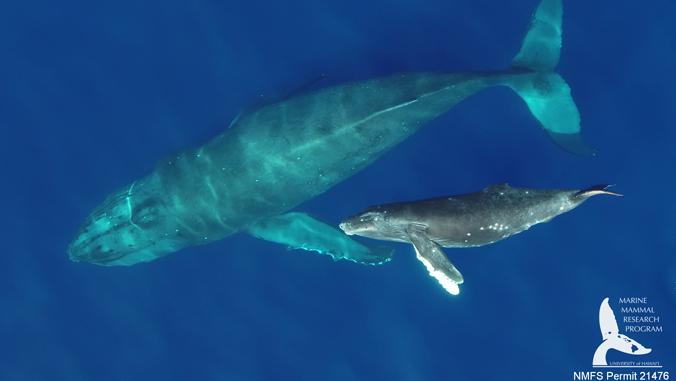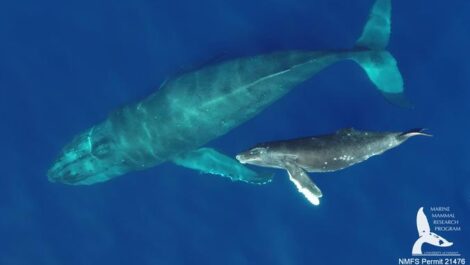Study finds humpback whales are shorter now than they were in mid-1900s

A new study has revealed that humpback whales are shorter than they were in the mid-1900s and there was an 80% drop in crude birth rates in Hawaii between 2013-18. Photo courtesy Martin van Aswegen
A concerning trend seems to be happening to humpback whales in their migration between the Northern Pacific and Hawaii.
According to a new study, the whales’ migrations are getting shorter and there was an 80% drop in crude birth rates in Hawaii from 2013-18.
Aided by the Pacific Whale Foundation on Maui, the study also found newborn humpback whales require 38 times more energy after birth compared to what they need to grow inside the womb.
“This study addresses a key piece of the energetic puzzle in estimating the cost of being a humpback whale in the North Pacific: the cost of growth,” said Martin Van Aswegen, lead author of the study and postdoctoral researcher at the Marine Mammal Research Program. “While previous research has shown that these whales must grow very large in a short period of time, the actual energetic expense of that accelerated growth remained unknown.”
According to the study, mature humpback whales are noticeably shorter today than they are in historical records, indicating a decline in body size of approximately 1-2 feet since the mid-1900s.
Recent signs of humpback population stress in the region include a 76.5% drop in mother-calf sightings and an estimated 80% drop in crude birth rates in Hawaii between 2013-18, according to the study.
The research said these declines coincided with the longest-lasting global marine heatwave, suggesting that low food availability prevented mothers from getting enough energy to meet the demands of a nursing calf. For calves and juveniles, their higher energy requirements make them more vulnerable.
The study was conducted through research from the University of Hawaii at Manoa Hawaii Institute of Marine Biology in collaboration with Alaska Whale Foundation and other groups such as the Pacific Whale Foundation.
“If humpback whales are to survive threats like extreme marine heatwaves and other stressors that result from human activity, we need to understand precisely how reproductive females accumulate and allocate energy to support the exponential costs of gestation and lactation,” said professor Lars Bejder, the director of the Marine Mammal Research program and a senior author of the study.
The findings were published in the Marine Ecology Progress Series.
The research also revealed that calves require 6-8 times the daily growth energy of an adult whale, and they achieve 30% of their total lifetime growth in less than their first year of life. In fact, more than 60% of a calf’s crucial energy needs for growth occur within the first 150 days of birth.
The study found that a mother’s ability to produce a large, healthy calf hinges on her own energy reserves. Smaller females, with lower energy reserves are more constrained in how often they can reproduce and how much they can invest in their offspring.
“By quantifying the energetic demands of growing big and strong, we provide crucial insight into how external pressures, including climate change and human disturbance, may affect the survival and resilience of these ocean giants,” said van Aswegen.
The team used drones to take high-resolution aerial photos of more than 1,500 humpback whales in Hawaii and Southeast Alaska.
He said the team’s humpback whale health database, comprising over 12,000 measurements of 8,500 individual whales in the North Pacific, is being used across several projects within the Marine Mammal Research Program and abroad.






